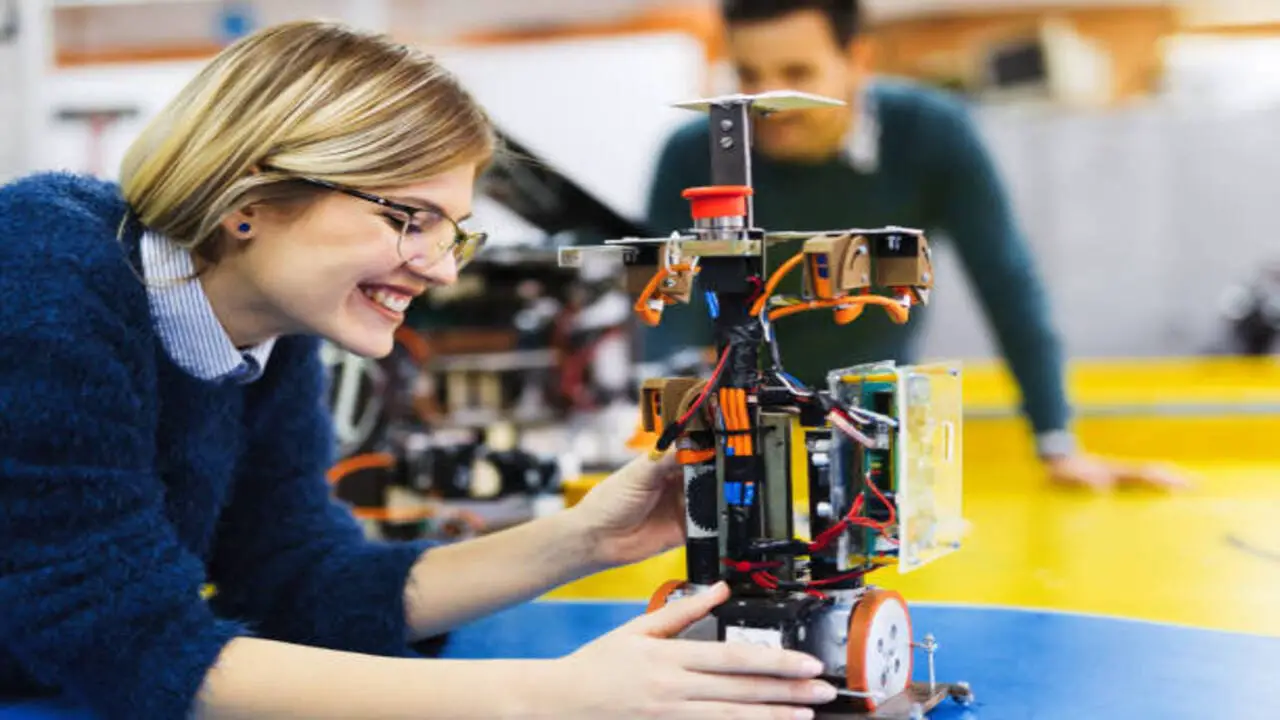The modern world stands on the brink of a technological revolution, where the convergence of robotics, artificial intelligence, and automation is reshaping industries and societies.
From manufacturing and healthcare to exploration and entertainment, robotics has transcended its once-fictional boundaries and emerged as a tangible force of innovation.
At the heart of this transformation lies a fundamental pillar: education. The universities that pioneer robotics education and research are not merely institutions; they are the crucibles where brilliant minds forge the future.
In this article, we embark on a journey to unravel the significance of selecting the right university for robotics studies, an expedition that will traverse the landscapes of academic excellence, cutting-edge research, and boundless creativity.
With a spotlight on the universities that lead the charge in shaping the future of robotics education, we will traverse the corridors of Massachusetts Institute of Technology (MIT), Stanford University, ETH Zurich – Swiss Federal Institute of Technology, University of Tokyo, and Carnegie Mellon University.
These institutions are not merely academic establishments; they are vibrant ecosystems where innovation, collaboration, and breakthroughs thrive.
Importance of Choosing the Right University for Robotics
The choice of university plays a pivotal role in shaping an individual’s robotics career. A well-regarded institution not only imparts technical knowledge but also fosters critical thinking, and problem-solving skills, and provides exposure to cutting-edge research.
The comprehensive learning environment of top universities often includes access to state-of-the-art laboratories, collaboration opportunities with experts, and networking prospects with peers who share the same passion for robotics.
Graduates from renowned universities often have an edge in the job market due to the credibility and reputation of their alma mater. Industry leaders actively seek talent from these institutions, recognizing the rigorous training and exposure students receive.
Moreover, the connections established during university years can lead to lifelong professional relationships and collaborations, both within academia and the industry.
Criteria for Evaluation
To determine the best universities for robotics education, several key criteria must be evaluated. These criteria encompass both the academic and practical aspects of robotics education:
- Faculty Expertise: Renowned universities stand out for their faculty members, who are often pioneers in robotics research. Their deep expertise not only imparts theoretical knowledge but also brings real-world insights, enriching the learning experience.
- Research Facilities: State-of-the-art laboratories equipped with cutting-edge technology offer students a playground for hands-on experimentation. These facilities serve as incubators for innovation, allowing students to explore concepts and push the boundaries of robotics.
- Industry Partnerships: Collaborations with industries provide students with exposure to real-world challenges and opportunities. Industry partnerships often lead to internships, joint projects, and networking events that bridge the gap between academia and practical applications.
- Alumni Success: The accomplishments of a university’s alumni can speak volumes about the quality of its programs. Graduates who have made significant contributions to robotics research founded successful startups, or secured influential positions in industry showcase the impact of their education.
- Curriculum Flexibility: Distinguished universities offer flexible curricula that blend foundational robotics principles with specialized areas of interest. This flexibility enables students to tailor their learning journey, ensuring they acquire both comprehensive knowledge and specialized expertise.
- Extracurricular Activities: Beyond traditional coursework, robotics clubs, hackathons, and competitions provide avenues for students to apply their skills in real-world scenarios. These activities foster collaboration, creativity, and practical problem-solving abilities.
- Support Services: Robust support services, including academic guidance, mentorship, and career counseling, create a conducive environment for students’ growth. Such services ensure that students receive both academic support and career guidance as they navigate the world of robotics.
Top Universities for Robotics Worldwide

When it comes to robotics education, certain universities have established themselves as global leaders, shaping the future of the field. Let’s delve into detailed overviews of five such institutions that stand at the forefront of robotics education and research:
1. Massachusetts Institute of Technology (MIT)
Massachusetts Institute of Technology (MIT) stands as a cornerstone of robotics education and innovation, with a legacy stretching back decades.
Home to the iconic Computer Science and Artificial Intelligence Laboratory (CSAIL) and the MIT Media Lab, MIT provides an environment where renowned faculty members like Rodney Brooks and Cynthia Breazeal push the boundaries of robotics research.
Their interdisciplinary approach merges computer science, engineering, and cognitive science, creating a fertile ground for holistic learning. A defining feature of MIT is its array of cutting-edge robotics laboratories.
The Biomimetics Robotics Lab, headed by Sangbae Kim, draws inspiration from nature to design robots that mimic biological systems, revolutionizing robotic locomotion and interaction.
The Robot Locomotion Group, led by Russ Tedrake, is a hub for quadrupedal and bipedal robotics research, contributing to the advancement of agile robotic motion.
MIT’s graduates continue to shape the field, with startups like iRobot, creators of the Roomba robotic vacuum, and Rethink Robotics, known for its collaborative robots, stemming from the institution’s nurturing environment.
2. Stanford University
Stanford University’s Robotics Lab is a testament to its commitment to pushing the boundaries of robotics education and research.
This lab, under the guidance of Professor Oussama Khatib, delves into diverse aspects of robotics, ranging from human-robot interaction to haptic feedback systems. However, what truly sets Stanford apart is its holistic approach that transcends traditional academic boundaries.
Interdisciplinary collaborations with fields like artificial intelligence and computer science foster innovation at the intersection of cutting-edge technologies.
Located in the heart of Silicon Valley, Stanford is uniquely positioned to leverage industry connections. The proximity to tech giants and startups provides students with unparalleled networking opportunities, internships, and exposure to real-world applications.
Stanford’s Robotics Club and initiatives like the Stanford Racing Team’s autonomous vehicle emphasize hands-on learning and practical problem-solving.
The university’s impact on the robotics landscape is exemplified by alumni-founded ventures like Savioke, known for its service robots deployed in the hospitality industry, showcasing the tangible outcomes of Stanford’s commitment to innovation.
3. ETH Zurich – Swiss Federal Institute of Technology
ETH Zurich’s reputation as a technology and engineering powerhouse extends to the realm of robotics education.
The university’s comprehensive approach ensures students are well-versed in foundational principles and exposed to cutting-edge robotics research.
At the heart of this endeavor lies the Institute of Robotics and Intelligent Systems (IRIS), helmed by renowned professors like Bradley Hayes and Roland Siegwart.
The institute’s research spectrum spans aerial robotics, medical robotics, swarm robotics, and more. What truly sets ETH Zurich apart is its dedication to industry collaboration and policy-making.
The university’s partnerships with industry leaders like ABB lead to collaborative research projects that drive innovation and shape industry practices.
Moreover, ETH Zurich’s involvement in European robotics initiatives positions it as a key player in shaping the future of robotics on a continental scale.
The university’s commitment to fostering innovation extends beyond academia, as reflected in the creation of spin-off companies that contribute to the European robotics ecosystem.
4. University of Tokyo
The University of Tokyo stands as a beacon of robotics innovation, with a legacy deeply rooted in its Graduate School of Information Science and Technology.
Within this institution lies the Nakamura Lab, led by Professor Masayuki Inaba, where students delve into a wide spectrum of robotics research, ranging from fundamental kinematics to the creation of human-friendly robots.
The lab’s projects, such as bipedal walking robots and versatile robotic arms, exemplify the lab’s commitment to merging theoretical knowledge with practical applications.
What truly sets the University of Tokyo apart is its integration of traditional craftsmanship with modern robotics. The Human Support Robot, a creation designed to assist people with disabilities, serves as a prime example.
By blending Japan’s rich cultural heritage with cutting-edge technology, the university produces robotics solutions that are not only functional but also culturally relevant.
The university’s close ties with Japanese tech giants like Toyota and Sony provide students with insights into real-world applications, offering a glimpse into the vast potential of robotics in various sectors.
5. Carnegie Mellon University
Carnegie Mellon University’s Robotics Institute is a global epicenter of robotics education and research, renowned for its multifaceted approach that extends beyond traditional academic boundaries.
Led by Professor Howie Choset, the institute emphasizes cross-disciplinary collaboration, evident in projects that blend robotics with arts and entertainment.
Notably, projects like robotic art installations and interactive exhibits underscore the institute’s commitment to exploring unconventional applications of robotics.
The institute’s National Robotics Engineering Center (NREC) is at the forefront of innovation in robotics for manufacturing and autonomous systems. Its work spans the development of self-driving cars, exploration robots, and even assistive devices for the visually impaired.
Carnegie Mellon’s real-world focus is underscored by its graduates, who have played pivotal roles in shaping the robotics landscape.
With a plethora of research centers, extracurricular opportunities, and industry collaborations, Carnegie Mellon University positions itself as an institution that not only imparts knowledge but also transforms students into accomplished roboticists who drive innovation across various domains.
Navigating Application and Admission
Aspiring roboticists looking to join these prestigious universities should keep in mind a few key points when preparing their applications.
Highlighting relevant experiences, such as research projects, internships, and personal robotics projects, can demonstrate genuine interest and dedication to the field. Crafting tailored application materials that align with each university’s strengths and focus areas is crucial.
Additionally, exploring financial aid options, scholarships, and assistantships is essential to manage the costs of education.
Many of these universities offer scholarships and opportunities for students to work as teaching or research assistants, easing the financial burden while providing valuable experience.
Conclusion
The world of robotics is evolving at an unprecedented pace, and the foundation for this evolution is laid by the education and research provided by universities.
The top universities for robotics education, such as MIT, Stanford, ETH Zurich, the University of Tokyo, and Carnegie Mellon, stand as beacons of excellence in shaping the future of robotics.
These institutions not only provide students with technical knowledge but also foster innovation, collaboration, and real-world problem-solving skills.
Aspiring roboticists should aim high and consider these institutions to embark on a journey that will contribute to the advancement of robotics and reshape the industries of tomorrow.
Additional Posts:

